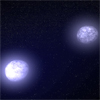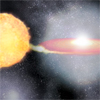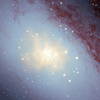CXC Home | Search | Help | Image Use Policy | Latest Images | Privacy | Accessibility | Glossary | Q&A
Tour of M31
Quicktime MPEG
This image of M31 represents a study of six elliptical galaxies that Chandra made to determine what causes an important type of supernova. At the heart of M31, also known as the Andromeda Galaxy, Chandra detects X-rays. The X-ray glow is partially caused by the aftermath of exploded stars known as supernovas. By examining the properties of the X-rays, scientists have figured out that one class of supernovas in these galaxies, known as Type Ia, are caused when two white dwarf stars merge. Understanding how Type Ia supernovas are triggered is important, since these objects are used to measure vast distances across the cosmos.
[Runtime: 00:47]
Quicktime MPEG
This image of M31 represents a study of six elliptical galaxies that Chandra made to determine what causes an important type of supernova. At the heart of M31, also known as the Andromeda Galaxy, Chandra detects X-rays. The X-ray glow is partially caused by the aftermath of exploded stars known as supernovas. By examining the properties of the X-rays, scientists have figured out that one class of supernovas in these galaxies, known as Type Ia, are caused when two white dwarf stars merge. Understanding how Type Ia supernovas are triggered is important, since these objects are used to measure vast distances across the cosmos.
[Runtime: 00:47]
(Credit: X-ray (NASA/CXC/MPA/M.Gilfanov & A.Bogdan), Infrared (NASA/JPL-Caltech/SSC), Optical (DSS))
Animation of Merger Trigger for Supernova
Quicktime MPEG
This animation shows the main way that new Chandra results indicate Type Ia supernova are triggered in elliptical galaxies. Two white dwarf stars orbit each other and lose energy via gravitational radiation, eventually resulting in a merger between the two stars. Because the total mass of this merger exceeds the weight limit for a white dwarf, the merged star is unstable and explodes as a Type Ia supernova.
[Runtime: 00:20]
Stills:
Quicktime MPEG
This animation shows the main way that new Chandra results indicate Type Ia supernova are triggered in elliptical galaxies. Two white dwarf stars orbit each other and lose energy via gravitational radiation, eventually resulting in a merger between the two stars. Because the total mass of this merger exceeds the weight limit for a white dwarf, the merged star is unstable and explodes as a Type Ia supernova.
[Runtime: 00:20]
(Credit: NASA/CXC/A.Hobart)
Stills:
Illustration of Alternate Trigger Mechanism
Quicktime MPEG
The first illustration shows an artist's illustration of gas being pulled from a Sun-like star onto a white dwarf via a red disk. When the amount of material accreted onto the white dwarf causes the weight limit for this star to be exceeded, it explodes as a Type Ia supernova, as shown in the second illustration. The latest results show that this is not the dominant mechanism for Type Ia supernovas in the galaxies Chandra observed.
[Runtime: 00:20]
View Illustration
Quicktime MPEG
The first illustration shows an artist's illustration of gas being pulled from a Sun-like star onto a white dwarf via a red disk. When the amount of material accreted onto the white dwarf causes the weight limit for this star to be exceeded, it explodes as a Type Ia supernova, as shown in the second illustration. The latest results show that this is not the dominant mechanism for Type Ia supernovas in the galaxies Chandra observed.
[Runtime: 00:20]
View Illustration
(Credit: NASA/CXC/M.Weiss)
Composite Image of M31
Quicktime MPEG
This composite image of M31 (Andromeda) shows Chandra X-ray data in gold, optical data from the Digitized Sky Survey in light blue and infrared data from the Spitzer Space Telescope in red. A zoom into the central region of M31 dissolves into the Chandra field of view. Scientists have calculated that the Chandra image would be about 40 times brighter than observed if Type Ia supernova in the bulge of this galaxy were triggered by accretion of material from a normal star onto a white dwarf star. This implies that the merger of two white dwarfs is the main trigger for Type Ia supernovas in this galaxy.
[Runtime: 00:12]
Quicktime MPEG
This composite image of M31 (Andromeda) shows Chandra X-ray data in gold, optical data from the Digitized Sky Survey in light blue and infrared data from the Spitzer Space Telescope in red. A zoom into the central region of M31 dissolves into the Chandra field of view. Scientists have calculated that the Chandra image would be about 40 times brighter than observed if Type Ia supernova in the bulge of this galaxy were triggered by accretion of material from a normal star onto a white dwarf star. This implies that the merger of two white dwarfs is the main trigger for Type Ia supernovas in this galaxy.
[Runtime: 00:12]
(Credit: X-ray (NASA/CXC/MPA/M.Gilfanov & A.Bogdan), Infrared (NASA/JPL-Caltech/SSC), Optical (DSS))
Return to Type Ia (February 17, 2010)











